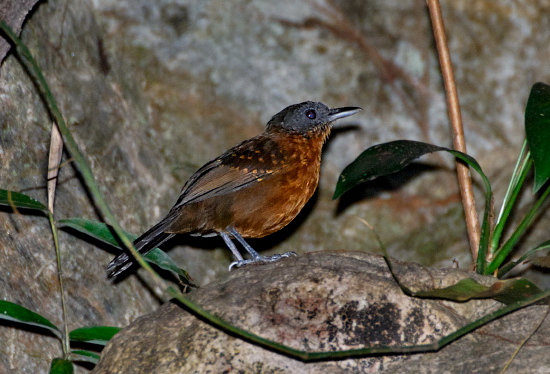| Line 1: | Line 1: | ||
| − | + | ||
;Percnostola caurensis | ;Percnostola caurensis | ||
[[Image:Caura_Antbird.jpg|thumb|550px|right|Photo by <b>Aracari in Serra do Aracá, AM - Brazil]] | [[Image:Caura_Antbird.jpg|thumb|550px|right|Photo by <b>Aracari in Serra do Aracá, AM - Brazil]] | ||
| Line 10: | Line 10: | ||
==Taxonomy== | ==Taxonomy== | ||
==Habitat== | ==Habitat== | ||
| − | The | + | The Caura Antbird typical habitat are mountainous open rainforest slopes with large boulders, often in steep terrain, at altitudes between 250 and 400m. They may also be seen at the borders of the forest, specially alongside mountain streams. The species seems to be very intolerant of other habitats, apparently never been recorded in areas of lowland rainforest, for instance. Due to these habitat requirements, the species is usually located at the slopes of the tepuis (table-top mountains) of the Guianan Plateau. |
==Behaviour== | ==Behaviour== | ||
| + | They are highly associated with large boulders, often foraging on these boulders or on the ground nearby, exploring its crevices filled with leaf litter and other organic debris after varied arthropods. They will also probe in the moss and ferns that may cover these rocks. They also glean their prey with very quick motions from vines and roots over the rocks. | ||
| + | |||
| + | The Caura Antbird may also squeeze themselves into small spaces between the rock and overlying dense tangle of roots, remaining under the protection of these "roofs" for up to a minute. They also vigorously toss dead leaves in the manner of a leaftosser (''Sclerurus sp.''). (''Zimmer, 1999''). Apparently it does not attend mixed species flocks of ant swarms. They often forage in pairs. | ||
| + | |||
==Bird Song== | ==Bird Song== | ||
==External Links== | ==External Links== | ||
Revision as of 02:06, 28 December 2007
- Percnostola caurensis
Identification
Distribution
The range of the Caura Antbird extends through the Guianan Plateau in Southern Venezuela (south of the Orinoco River, Bolivar and Amazonas) and extreme north Brazil, in the state of Amazonas. The bird is endemic to the mountains and tepuis (see "habitat") within this area.
It may also possibly occur on the NW end of Roraima State in Brazil.
Taxonomy
Habitat
The Caura Antbird typical habitat are mountainous open rainforest slopes with large boulders, often in steep terrain, at altitudes between 250 and 400m. They may also be seen at the borders of the forest, specially alongside mountain streams. The species seems to be very intolerant of other habitats, apparently never been recorded in areas of lowland rainforest, for instance. Due to these habitat requirements, the species is usually located at the slopes of the tepuis (table-top mountains) of the Guianan Plateau.
Behaviour
They are highly associated with large boulders, often foraging on these boulders or on the ground nearby, exploring its crevices filled with leaf litter and other organic debris after varied arthropods. They will also probe in the moss and ferns that may cover these rocks. They also glean their prey with very quick motions from vines and roots over the rocks.
The Caura Antbird may also squeeze themselves into small spaces between the rock and overlying dense tangle of roots, remaining under the protection of these "roofs" for up to a minute. They also vigorously toss dead leaves in the manner of a leaftosser (Sclerurus sp.). (Zimmer, 1999). Apparently it does not attend mixed species flocks of ant swarms. They often forage in pairs.




